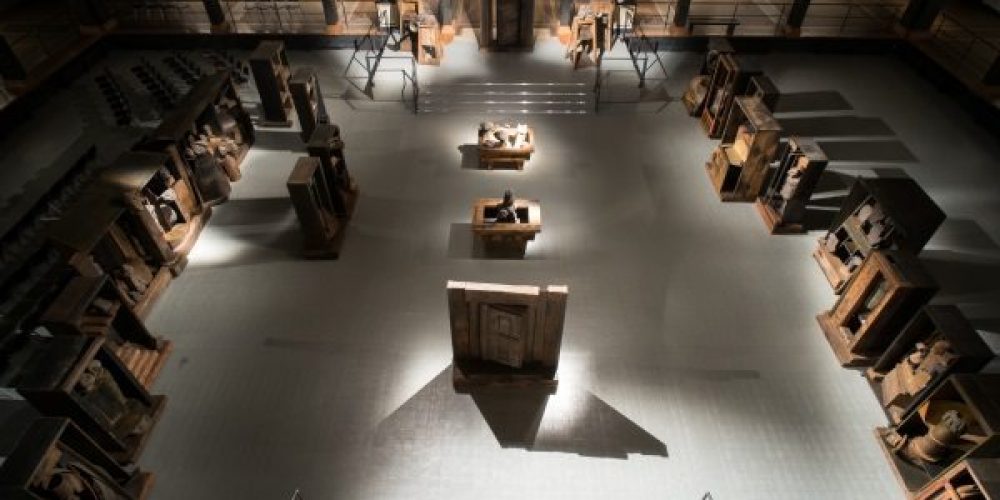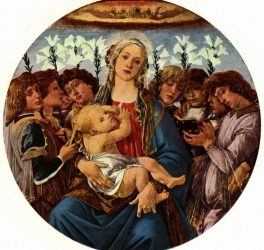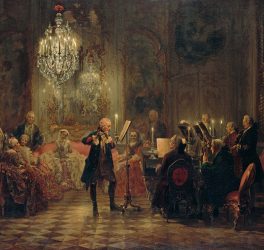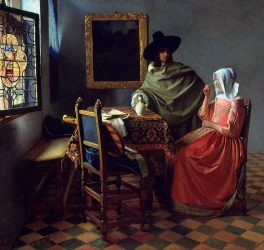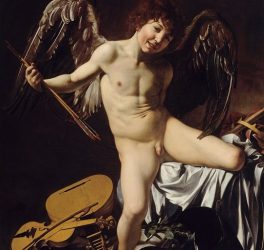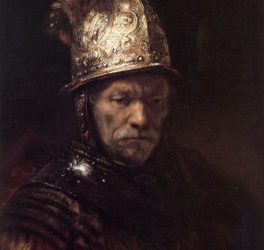until 10.01. | #0211ARTatBerlin | From 11 September 2015, the Martin-Gropius-Bau will present the exhibition “From Hockney to Holbein. The Würth Collection in Berlin”.
The Würth Collection is one of the largest private collections in Europe, containing around 17,000 works of art. The most important of the classic modern artists are represented, as well as masterpieces from the Middle Ages and classic works of contemporary art. The exhibition truly enriches ‘Kunstherbst Berlin’ i.e.‘Berlin’s Autumn of Art’, today known as the Berlin Art Week. With more than 400 works of art of international significance, the collection will be presented to the public in a scope never previously seen, in an exhibition space spread across 27 rooms of the Berlin based Martin-Gropius-Bau, one of the most reknowned exhibition halls in Europe.
Analogously to the history of the Würth Collection, the exhibition delves from the present back into the history of art. Surprises are to be expected. Among the works on display are David Hockney’s season cycle, an international
collection of sculptures by artists from Eduardo Chillida to Henry Moore, masterpieces of classical modernism from artists such as Pablo Picasso and Edvard Munch, breathtaking works of decorative art, and a selection of the Würth Collection’s Old Masters, including one of the most significant paintings of the 16th century, Hans Holbein the Younger’s “The Madonna With the Family of Mayor Meyer”. A further highlight is the 25-piece monumental installation “The Last Judgement Sculpture” by British sculptor Anthony Caro in the spectacular atrium of the Martin-Gropius-Bau, which the Brit once created for the Biennale in Venice.
The exhibition has provided collector Reinhold Würth, who celebrated his 80th birthday this year, the opportunity to continue to pursue his contribution to the Berlin art scene. His work launched in 2006, with the establishing of a Chamber of Art in the newly reopened Bode-Museum. Reinhold Würth’s passion for collecting art was triggered by the work of Emil Nolde. However, another of his purchases was a work by the Danish Constructivist Robert Jacobsen. This proved Würth’s collector gateway to the postwar Parisian Modernists gathered around the legendary Galerie Denise René, the world of Hans Arp, Sonja Delaunay-Terk, Serge Poliakoff, Aurélie Nemours, Fernand Léger, Günter Fruhtrunk, Jean Dewasne, Auguste Herbin, Victor Vasarely, Jesús Rafael Soto and others, for whose works the exhibition granted an especially wide space. Via Jacobsen, contemporary sculpture would soon represent a substantial size of the collection. Over the years entire ensembles of works would expand in this manner. For instance, the Basque Eduardo Chillida represented in the exhibition on sculptures and works on paper, including his significant works Gravitation and The Art of Fugue by Johann Sebastian Bach.
To Austria’s Alfred Hrdlicka, who can be seen in the exhibition with his 1965 work Hansi, his sculpture of a renowned Vienna prostitute; or to Max Bill, whom the exhibition has likewise acknowledged with a dedicated room, as it has Britain’s Anthony Caro, and Bulgarian-American artist couple Christo and his wife Jeanne-Claude, who in 1995 covered both the Reichstag in Berlin and the Museum Würth in Künzelsau.
Since the collection does not follow a narrow, canonical concept, but displays openness reflected in its diversity, furthermore on display are important works of modern sculpture by Barbara Hepworth, Henry Moore, Magdalena Abakanowicz, Richard Deacon, Barry Flanagan, Antony Gormley, Eduardo Paolozzi, Erwin Wurm, Jaume Plensa, and Tony Cragg.
A room containing some 50 artworks, art books, original collages, paintings and sculptures identifies surrealist Max Ernst as one of the central figures of the collection. Here you will find Max Ernst incunabula such as the painted doors from the house of Paul Eluard in Eaubonne from 1923, or the original plaster figure of his Young Man with Beating Heart from 1944, towards the end of the Second World War. Complementing the already strongly represented surrealism (also to be seen are
significant works by André Masson and René Magritte) are magical paintings of Mexican modernism, from Rufino Tamayo to Francisco Toledo. Important movements of classical modernism, in particular German late Impressionism and Expressionism, are a further focal point of the collection, with Max Beckmann, Ernst Ludwig Kirchner, Max Liebermann and Edvard Munch among the most significant artists represented. Superb groups of works by Georg Baselitz and Anselm Kiefer illustrate the process-orientated nature of history and memory. The erotically charged late work of Pablo Picasso is countered by David Hockney’s striking cycle of the four seasons, representing the poetry of plein air painting and housed in a separate room.
The Old Masters form yet another collection within the collection. A significant impetus was provided by the acquisition of the collection of late mediaeval Old Masters from the castle of Donaueschingen. The Würth Collection would provide them with the platform to make the connection with the modern age spectacularly complemented by Lucas Cranach the Elder and Hans Holbein the Younger. In Berlin you will come across Alex Katz, Fernando Botero, Alfred Hrdlicka and Katsura
Funakoshi.
A manifest expression of the passionate love of Reinhold Würth for collecting is shown by the collection of precious objets d’art from the “cabinets of curiosities” of the 17th and 18th centuries. The exhibition has reserved a dedicated room for this collection. It is the heartbeat of the exhibition as it were. It is here, together with other precious small sculptures of the 18th and 19th century that you can see not only the Arch-Cupbearer’s Cup of the Count of Limpurg dating from the 1561 – one of the most significant pieces of goldsmith works of the German High Renaissance – but also a Madonna by Edvard Munch from 1895, Carl Spitzweg’s The Private Lesson from 1845, Yves Klein’s Monogold from 1959 and Marc Quinn’s golden
boy AAA GTATA GGCAG from 2009. This dedicated room is also where the threads come together of a highly complex network of acquisitions, which the exhibition spreads across two floors.
The following artists are presented in the exhibition:
Magdalena Abakanowicz, Max Ackermann, Horst Antes, Siegfried Anzinger, Karel Appel, Hans (Jean)Arp, Paulus Ättinger, Stephan Balkenhol, Hans Baschang, Georg Baselitz, Jean-Michel Basquiat, Philipp Bauknecht, Willi Baumeister, Max Beckmann, Barthel Beham, Johann Jakob Betzold, Max Bill, Nicolas Bille, Johann Philipp Bonhöffer, Fernando Botero, Herbert Brandl,Daniel Buren, Barthèlemy Caballe, Alexander Calder, Anthony Caro, Sandro Chia, Eduardo Chillida, Giorgio de Chirico, Christo, Johannes Clauss, Francesco Clemente, Tony Cragg, Lucas Cranach d. Ä., Lucas Cranach d. J., Salvador Dalí, Gunter Damisch, Hans Daucher, Richard Deacon, Sonia Delaunay-Terk, Jean Dewasne, Oliver Dorfer, Adam Bernhard Eckard, Paul Ecklott, Paul Egell, Johann Eissler, Paul Eluard, Hans Magnus Enzensberger, Max Ernst, Rainer Fetting, Barry Flanagan, Adolf Fleischmann, Lucio Fontana, Jean-Baptiste Fouache, Günther Fruhtrunk, Katsura Funakoshi, Günter Grass, Hap Grieshaber, Antony Gormley, Hans Hartung, Rudolf Hausner, Xenia Hausner, Barbara Hepworth,
Auguste Herbin, André Heurtaux, David Hockney, Karl Horst Hödicke, Rudolf Hoflehner, Hans Holbein d. J., Alfred Hrdlicka, Friedensreich Hundertwasser, Jörg Immendorff, Robert Jacobsen, Anish Kapoor, Alex Katz, Johann Georg Kern, Leonhard
Kern, Stephan Kern, Anselm Kiefer, Ernst Ludwig Kirchner, Herbert Kitzel, Yves Klein, Kurt Kocherscheidt, Leon Kossoff, Dieter Krieg, Hans Süss von Kulmbach, Frantisek Kupka, Fernand Léger, Thomas Lenk, Roy Lichtenstein, Max Liebermann, Esaias zur Linden, Egidius Lobenigk, Markus Lüpertz, Alberto Magnelli, René Magritte, Jacek Malczewski, Heinrich Mannlich, Piero Manzoni, André Masson, Joan Miró, Henry Moore, François Morellet, Edvard Munch, Ernst Wilhelm Nay, Aurélie Nemours, Emil Nolde, Tony Oursler, Eduardo Paolozzi, A. R. Penck, Benjamin Péret, Pablo Picasso,
Jaume Plensa, Serge Poliakoff, Peter Pongratz, Marc Quinn, Arnulf Rainer, Gerhard Richter, Tilman Riemenschneider, Adolfo Riestra, Christoph (II.) Ritter, Dieter Roth, Christian Schad, Hermann Scherer, Oskar Schlemmer, Claude Émile Schuffenecker, Emil Schumacher, Jesús Rafael Soto, Carl Spitzweg, Henryk Stazewski, Matthias Steinl, Walter Stöhrer, Bernhard Straus , Bernhard Strigel, Rufino Tamayo, Jean Tinguely, Francisco Toledo, Lun Tuchnowski, Günther Uecker, Tomi Ungerer, Victor Vasarely, Andy Warhol, Lambert Maria Wintersberger, Walter Wörn, Paul Wunderlich, Erwin
Wurm.
The team of curators responsible for the exhibition comprises the curators of the Würth Collection under the direction of C. Sylvia Weber as well as the members of the Art Council of the Würth Group, with Christoph Becker, Thomas W. Gaehtgens, Fabrice Hergott, Martin Roth and Peter-Klaus Schuster. A comprehensive educational programme will make the collection accessible to a broad range of visitors. Exhibition architect was Lun Tuchnowski.
Exhibition period: Friday, 11th September 2015 to Sunday, 10th January 2016
[maxbutton id=”93″]
Image Caption: Anthony Caro: The Last Judgement Sculpture, 1995-1999. Installation mit 25 Skulpturen, Steingut, Beton, Holz, Messing und Stahl, variable Maße Inv. 5417–5441. View of the installation in the Atrium of the Martin-Gropius-Bau
© Sammlung Würth, Photo: Mathias Völzke, 2015
Würth Collection at Martin Gropius Bau – Exhibitions in Berlin ART@Berlin

